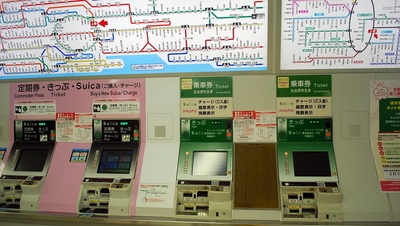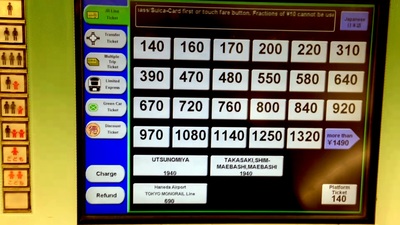How to Buy Metro and Train Tickets in Tokyo
The subway and urban railway networks in Tokyo are the most efficient and convenient ways to get around the city. If you’re planning a trip to Tokyo, it’s important to know how to purchase tickets. Fortunately, nowadays, there’s no need to buy paper tickets because there are many more convenient alternatives. However, it’s still useful to understand how the system works in case you need to. On this page, we’ll provide all the information you need to buy Tokyo subway tickets: the different options available, such as single tickets, daily passes, and discounted tickets, the purchase process, how to calculate the ticket cost, and how to read subway maps.
How to Buy Tickets
Paper Tickets Are Not Necessary
Buying paper tickets is strongly discouraged nowadays. On one hand, it’s not very straightforward, as we’ll see, to purchase a new ticket each time you want to take the subway, and it also wastes precious time. Fortunately, for many years now, there have been more convenient alternatives that almost everyone uses in Tokyo, namely:
- Using a prepaid SUICA or PASMO card. If you have a prepaid card, there’s no need to buy a ticket. Just keep the card loaded with enough money and go directly to the turnstiles. Once you reach your destination, you’ll pass the card again at the exit turnstiles, and the amount corresponding to the distance traveled will be deducted. Click here for more information on how to obtain and use SUICA, PASMO, and similar prepaid cards. We always recommend getting a prepaid card as soon as you arrive at the airport because it will be very useful in Tokyo and throughout the rest of the country. Prepaid cards work throughout Japan for any type of public transportation, with very few exceptions.
- Using one of the available daily passes, which allow unlimited use of Tokyo’s public transport for 24, 48, or 72 hours, depending on the pass purchased. However, it’s not always economical to buy this type of pass, which is also not valid on every line in the city because Tokyo has many different companies managing public transport. It’s advisable to take a look at our guide to Tokyo subway daily passes.
How to Buy a Paper Ticket
It’s good to know how paper tickets work for any unforeseen circumstances. For instance, you might realize you’ve lost your prepaid card while exploring Tokyo. Paper tickets can be purchased from vending machines, where the initial screen always offers English and sometimes Chinese and Korean languages.
To purchase the correct ticket, you need to select the fare you want to buy, not the destination station. To buy the correct ticket, you need to know the fare for the distance you intend to travel. Here’s how to find out the correct fare:
- Above the vending machines, there is usually a large map of the entire subway or railway network of that transport company. Under each station, you’ll find a number indicating the cost to reach that station from your current station. These maps are not always available in English and are often written only in Japanese characters, which can be difficult for a foreigner to decipher.
- If you have internet access, you can check (even in advance at your hotel if needed) the fare for the route using one of the many online services like Hyperdia or Google Maps.
- If you have no idea of the fare to pay, you can purchase a ticket at the minimum available fare, and then, once you reach your destination, use a fare-adjustment machine to pay any additional cost. These machines are located next to the exit turnstiles at any station. They are used when you have a wrong ticket (with a lower fare than needed to leave the station) or when you don’t have enough money on your prepaid card. With this machine, you can recharge your card with new funds or pay the difference between the fare required and the fare of the paper ticket you have.

 Typical JR ticket machines and displays for selecting the fare you want to purchase
Typical JR ticket machines and displays for selecting the fare you want to purchase
How Much the Tokyo Subway Costs
As we have extensively explained, Tokyo subway fares, and more generally all public transportation in Japan, including metro, trams, trains, and buses, vary depending on the distance traveled. For brevity, here are the fares for the three main operators: Tokyo Metro, Toei Metro, and JR. The distances are the actual kilometers traveled by the train, not the straight-line distance.
Tokyo Metro Fare Prices
- 1-6 km: 170¥
- 7-11 km: 200¥
- 12-19 km: 250¥
- 20-27 km: 290¥
- 28-40 km: 320¥
Toei Metro Fare Prices
- 1-4 km: 180¥
- 5-9 km: 220¥
- 10-15 km: 280¥
- 16-21 km: 330¥
- 22-27 km: 380¥
- 28-46 km: 430¥
Urban JR Railway Fare Prices
For JR, the price depends on various factors and cannot be summarized in a brief list. JR tends to cost less than the metro for very short distances. For distances of 20 km and beyond, the subway becomes more economical. The fares for the JR Yamanote Line, the circular line, range from a minimum of 140¥ to a maximum of 270¥.
Guided tours, activities and other things to do
If you are planning a trip to Japan and you want to do something more than just visiting famous places and monuments, we suggest you to use
Rakuten Travel Experiences.
How to use Rakuten Travel Experiences
Rakuten Travel is a very useful website to
enrich your travel experience, especially if you are going solo or it's your first time in Japan.
Because of the language barrier (and more), in Japan it is very difficult to interact with the locals and to get off the tourist track.
Thanks to Rakuten Travel you can find a lot of interesting and sometimes unique
guided tours and activities all over Japan (and not only in Japan), that you would otherwise never be able to enjoy.
But there's more: on Rakuten Travel you can also
buy tickets for several famous attractions, events, transportation and other useful services for tourists. Last but not least, you can
reserve a table in hundreds of restaurants.
Some examples
Take a look at Rakuten Travel Experiences
You may also be interested in